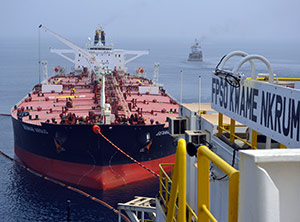Special topics
 The Ghana Shippers’ Authority (GSA) has revealed that the rising bunker prices has narrowed the profitability in the container market despite the growth in economic outlook and world merchandise trade in the first half of the year.
The Ghana Shippers’ Authority (GSA) has revealed that the rising bunker prices has narrowed the profitability in the container market despite the growth in economic outlook and world merchandise trade in the first half of the year.
According to the GSA, the average bunker prices from January-June increased by 25 per cent compared to the average prices recorded in 2017.
However, as a measure to deal with the high bunker prices, carriers had resorted to slow steaming to improve their profitability.
Again, there was the slowing down of ship orders, which could lead to higher freight charges by those shipping lines.
The Authority, therefore, advised shippers to lock-in long term contracts with carriers in order to avert the foreseeable hikes in freight rates.
Bunker Adjustment Factor (BAF) or Bunker-surcharge refers to floating part of sea freight charges, which represents additions due to oil prices. Therefore, BAF charges used to be determined by Carrier Conference to be applicable for a certain period on a certain trade route.
Madam Benonita Bismarck, the Chief Executive Officer of the GSA, gave the advice when she read the first half report of the Shipping Quarter and Outlook in Accra.
The event, which was instituted by the GSA, provided the platform to discuss the happenings in the shipping and trade sectors of the economy and to engage the media to inform them on timely and accurate information in the shipping industry, particularly trade performance of the country.
The performance of the country’s containerised cargo trade showed that 23 shipping lines were involved in the containerised cargo trade, which amounted to 328,801 TEUs for the first half of the year.
The highest operators were Maesk Line, with 108,310 TEUs (32.9% of the container trade) and Mediterranean Shipping Company with 65,682TEUs (19.9%).
The report indicated that a total of 87 shipping lines and charterers participated in transporting the over 11.75 million mt of Ghana’s seaborne cargo (imports and exports) through the ports of Tema and Takoradi.
Under the export trade, 4.03 million mt of seaborne exports went to the various destinations in the world.
For instance, Far East Range received a total of 2, 083,474mt (ie 52% of total exports) whilst the other markets received a total of 1,252,922mt (or 31% of total exports).
Meanwhile, the majority of the country’s seaborne imports trade came from the Far East Range (Asia) totalling 1,904,317 metric tonnes (mt), representing 27 per cent of the total import trade.
Twenty-five per cent of the import trade (1,802,427 mt) came from Africa, an increase of 10.4 per cent over the previous year’s figure of 1. 63 million mt.
The major commodities imported from the Africa Range, which experienced significant increases were petroleum products, clinker and crude oil.
Other trade range includes the United Kingdom 95,528 mt, North Continent 1,297,662 mt, Middle East 1,319,304 mt, North America 273,039 mt and 463,446 mt.
The report indicated that Ghana’s maritime trade outlook was positive and impressive with a total import trade volume of 7.16 million mt compared to 6.75 million mt recorded in the same period last year.
This comprised 2.93 million mt of Liner cargo 863,751 mt of Break bulk, 1,708,944 mt of Dry bulk cargo and 1,656,733 mt of Liquid bulk imports. Some commodities imported included cars, secondhand clothing, meat, petroleum products, among others.
The imports volume increased by 5.9 per cent compared to 2017 for the trade types. There were recorded increases in liner imports and break bulk imports of 15.6 per cent and 17.9 per cent respectively.
There were, however, recorded decreases of 1.2 per cent and 5.9 per cent in dry bulk and liquid bulk imports.
The report said the country’s cargo throughputs for the first half of 2018 posted an increase of 14.3 per cent compared to the same period last year.
For instance, the country recorded 11,753,594 mt cargo throughputs from January-June, compared to 10,283,720 mt in 2017, representing 14.29 per cent increase.
Of the 11. 75 million mt cargo throughputs, Tema Port recorded 8.1 million mt representing 69 per cent, while Takoradi recorded 3.65 million mt of the total trade volume, representing 31 per cent.
Meanwhile, the transshipment imports amounted to 522,012mt, whilst transit exports recorded 49,042mt.
The report said the nation recorded total trade volume of 4.03 million mt, representing 33.5 per cent increase over that of 2017, comprising 1,173,024 mt, of Liner items, 148, 972 mt of Break bulk items, 2,560,776 mt of Dry bulk and 144,023 mt of Liquid bulk